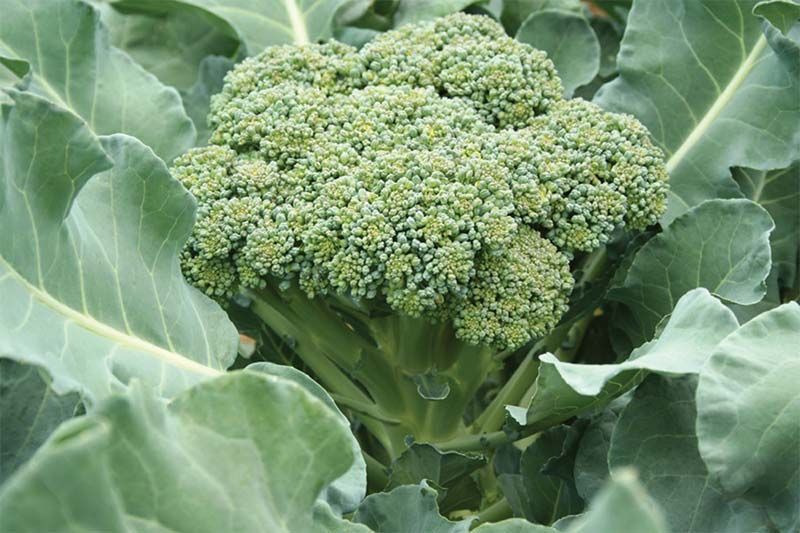Jeff Green | May 03, 2017
The vegetable of the year for 2017 is more than just one vegetable, it’s an entire family, even an entire category. They used to be called cruciferous vegetables, not because of their crunch but because of their small flowers. The four petal flower looks something like a cross, hence the latin name crucifera referring to the crucifixion. Botanists now call them brassicas and farmers call them cole plants.
They include all of the vegetables in the cabbage and mustard family, a powerhouse of nutrition and strong flavours. As garden plants they are very well suited to cooler climate, and are generally pretty easy to grow.
They include cabbage, broccoli, cauliflower, Brussel sprouts, collards, bok choy, nappa, kale, kohlrabi, radish, tatsoi, turnip, and rutabaga and more. The easiest one to grow is the garden radish, of which there are many varieties available. Many gardeners use radishes to mark the ends or limits of rows where slower growing direct seeded plants, such as beets and carrots, are planted because they come up within days and can be harvested quickly, in a few weeks.
Brassicas are mostly well suited to our climate and they tend to like well drained soils and prefer wet rather than dry conditions. Some of them can be started indoors but they tend not to like to be disturbed so they are best started in peat pots that can be plugged into the ground when they go out. There are no real issues with frost so seeds can be planted or plants transplanted at any time.
The main concern is bugs (flea beetles, aphids, cabbage worms, cabbage loopers, etc) and for those who like to do multiple plantings throughout the season the best thing to do is not to plant in the same location twice.
With some brassicas, the leaves are harvested (kale, bok choy, arugula) with some the swollen half above ground roots are harvested (turnips, radishes, kohlrabi) and with some it is the flower head that is eaten (broccoli, cauliflower). The advantage of growing brassicas, whose leaves or flower heads are the crop we are looking for, is that the plant survives the harvest and keeps growing on to be harvested repeatedly.
We will look at one Brassica that local gardeners might consider growing this year.
Broccoli – It takes more work to bring broccoli plants to maturity than some of the other brassicas, But once the plants are large enough and the central head is harvested, the side shoots develop and the harvest can continue until well after the first frost of the season.
To start broccoli in the spring, many gardeners plant the seeds indoors in April and set out small seedlings in mid May, but they can be direct seeded in May. They can be seeded about 110 days before he first frost, which in our region is between mid-May to early June. They need room so seeds or seedlings need to be between 12 and 24 inches apart.
They do not like the hot weather but they really hate drought conditions so watering is imperative. Their roots are shallow so mulching is a better idea than cultivating or weeding the soil near the plant. The best thing about garden broccoli is the payoff. Whether you have one or ten mature plants in your garden, the taste and texture of garden broccoli puts store bought broccoli to shame. And you can keep eating fresh broccoli until November.
One hint about cooking broccoli. Don’t boil it to the point of mush. In stir fries, peel and cut up the stalk and put it in earlier, and once the stalks soften, toss in the flower heads at the very end, cover and steam just until they turn dark green and start to sweat, then stir into the other hot vegetables.
They can also be cooked in a steamer or in a small amount of boiling water, again stocks first until they soften, then the flowers for a short time. Drain and throw the cooked broccoli in a bowl with some olive oil and balsamic vinegar and sprinkle finely chopped raw garlic over top and toss everything together. Let sit for five minutes for vinegar and garlic to seep into the warm broccoli and start eating. By the time the rest of the dinner is ready and everyone is gathered at the table the broccoli will probably be gone, picked away at by passers by.
More Stories
- No Winner Yet in Catch The Ace But Fundraising Target Met
- South Frontenac Food Bank Opens Second Location in Battersea
- Sharbot Lake Pentecostal Church Anniversary - 1925-2025
- Frontenac Holistic Health Fair - September 20 At Storrington Centre
- Odd Year For Real Estate - But Sales Are Steady Year Over Year
- 193rd Kingston Fall Fair
- Kim Phuc - the Napalm Girl - To Visit Flinton In November
- South Frontenac Council - September 2
- Sticker Shock - EV Charging Station To Cost North Frontenac Township
- 30th Anniversary Verona Car Show

